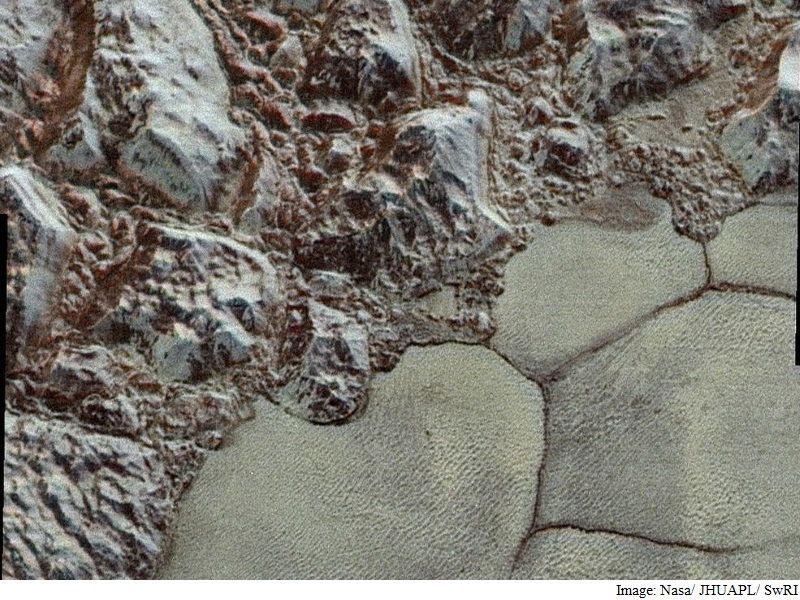- Home
- Science
- Science News
- Nasa Releases Enhanced Colour Mosaics of Pluto
Nasa Releases Enhanced Colour Mosaics of Pluto

The pictures are part of a sequence taken near New Horizons' closest approach to Pluto during its July 14 flyby.
It has resolutions of about 250-280 feet per pixel - revealing features smaller than half a city block on Pluto's surface.
Lower resolution colour data (at about 2,066 feet per pixel) were added to create this new image.
The images form a strip 80km wide, trending from the edge of "badlands" northwest of the informally named Sputnik Planum, across the al-Idrisi mountains, onto the shoreline of Pluto's "heart" feature and just into its icy plains.
The wide variety of cratered, mountainous and glacial terrains gives scientists and the public alike a breathtaking, super-high-resolution colour window into Pluto's geology.
New sharp images of Pluto have revealed a bewildering variety of surface features that have scientists reeling because of their range and complexity.
The images reveal new features as diverse as possible dunes, nitrogen ice flows that apparently oozed out of mountainous regions onto plains, and even networks of valleys that may have been carved by material flowing over Pluto's surface.
"Pluto is showing us a diversity of landforms and complexity of processes that rival anything we have seen in the solar system," said New Horizons principal investigator Alan Stern from Southwest Research Institute (SwRI), Boulder, Colorado.
New Horizons has begun its year-long download of new images and other data.
For the latest tech news and reviews, follow Gadgets 360 on X, Facebook, WhatsApp, Threads and Google News. For the latest videos on gadgets and tech, subscribe to our YouTube channel. If you want to know everything about top influencers, follow our in-house Who'sThat360 on Instagram and YouTube.
Related Stories
- Samsung Galaxy Unpacked 2025
- ChatGPT
- Redmi Note 14 Pro+
- iPhone 16
- Apple Vision Pro
- Oneplus 12
- OnePlus Nord CE 3 Lite 5G
- iPhone 13
- Xiaomi 14 Pro
- Oppo Find N3
- Tecno Spark Go (2023)
- Realme V30
- Best Phones Under 25000
- Samsung Galaxy S24 Series
- Cryptocurrency
- iQoo 12
- Samsung Galaxy S24 Ultra
- Giottus
- Samsung Galaxy Z Flip 5
- Apple 'Scary Fast'
- Housefull 5
- GoPro Hero 12 Black Review
- Invincible Season 2
- JioGlass
- HD Ready TV
- Laptop Under 50000
- Smartwatch Under 10000
- Latest Mobile Phones
- Compare Phones
- Moto G15 Power
- Moto G15
- Realme 14x 5G
- Poco M7 Pro 5G
- Poco C75 5G
- Vivo Y300 (China)
- HMD Arc
- Lava Blaze Duo 5G
- Asus Zenbook S 14
- MacBook Pro 16-inch (M4 Max, 2024)
- Honor Pad V9
- Tecno Megapad 11
- Redmi Watch 5
- Huawei Watch Ultimate Design
- Sony 65 Inches Ultra HD (4K) LED Smart TV (KD-65X74L)
- TCL 55 Inches Ultra HD (4K) LED Smart TV (55C61B)
- Sony PlayStation 5 Pro
- Sony PlayStation 5 Slim Digital Edition
- Blue Star 1.5 Ton 3 Star Inverter Split AC (IC318DNUHC)
- Blue Star 1.5 Ton 3 Star Inverter Split AC (IA318VKU)

















